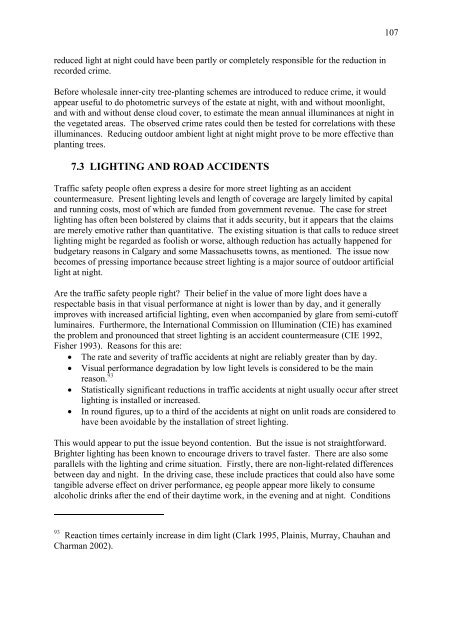Outdoor Lighting and Crime - Amper
Outdoor Lighting and Crime - Amper
Outdoor Lighting and Crime - Amper
Create successful ePaper yourself
Turn your PDF publications into a flip-book with our unique Google optimized e-Paper software.
educed light at night could have been partly or completely responsible for the reduction in<br />
recorded crime.<br />
Before wholesale inner-city tree-planting schemes are introduced to reduce crime, it would<br />
appear useful to do photometric surveys of the estate at night, with <strong>and</strong> without moonlight,<br />
<strong>and</strong> with <strong>and</strong> without dense cloud cover, to estimate the mean annual illuminances at night in<br />
the vegetated areas. The observed crime rates could then be tested for correlations with these<br />
illuminances. Reducing outdoor ambient light at night might prove to be more effective than<br />
planting trees.<br />
7.3 LIGHTING AND ROAD ACCIDENTS<br />
Traffic safety people often express a desire for more street lighting as an accident<br />
countermeasure. Present lighting levels <strong>and</strong> length of coverage are largely limited by capital<br />
<strong>and</strong> running costs, most of which are funded from government revenue. The case for street<br />
lighting has often been bolstered by claims that it adds security, but it appears that the claims<br />
are merely emotive rather than quantitative. The existing situation is that calls to reduce street<br />
lighting might be regarded as foolish or worse, although reduction has actually happened for<br />
budgetary reasons in Calgary <strong>and</strong> some Massachusetts towns, as mentioned. The issue now<br />
becomes of pressing importance because street lighting is a major source of outdoor artificial<br />
light at night.<br />
Are the traffic safety people right? Their belief in the value of more light does have a<br />
respectable basis in that visual performance at night is lower than by day, <strong>and</strong> it generally<br />
improves with increased artificial lighting, even when accompanied by glare from semi-cutoff<br />
luminaires. Furthermore, the International Commission on Illumination (CIE) has examined<br />
the problem <strong>and</strong> pronounced that street lighting is an accident countermeasure (CIE 1992,<br />
Fisher 1993). Reasons for this are:<br />
• The rate <strong>and</strong> severity of traffic accidents at night are reliably greater than by day.<br />
• Visual performance degradation by low light levels is considered to be the main<br />
reason. 93<br />
• Statistically significant reductions in traffic accidents at night usually occur after street<br />
lighting is installed or increased.<br />
• In round figures, up to a third of the accidents at night on unlit roads are considered to<br />
have been avoidable by the installation of street lighting.<br />
This would appear to put the issue beyond contention. But the issue is not straightforward.<br />
Brighter lighting has been known to encourage drivers to travel faster. There are also some<br />
parallels with the lighting <strong>and</strong> crime situation. Firstly, there are non-light-related differences<br />
between day <strong>and</strong> night. In the driving case, these include practices that could also have some<br />
tangible adverse effect on driver performance, eg people appear more likely to consume<br />
alcoholic drinks after the end of their daytime work, in the evening <strong>and</strong> at night. Conditions<br />
93<br />
Reaction times certainly increase in dim light (Clark 1995, Plainis, Murray, Chauhan <strong>and</strong><br />
Charman 2002).<br />
107
















